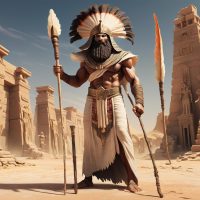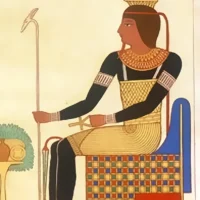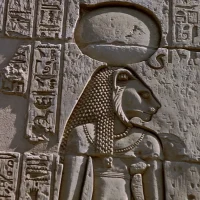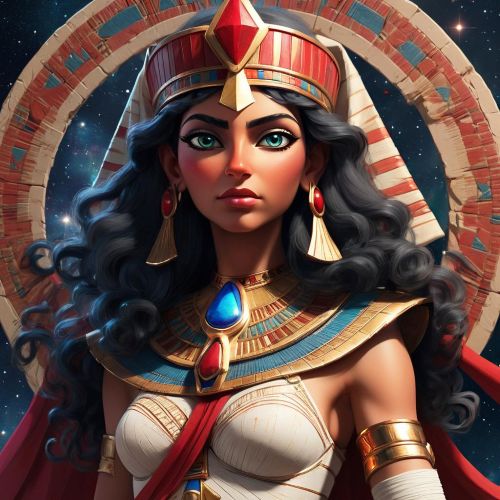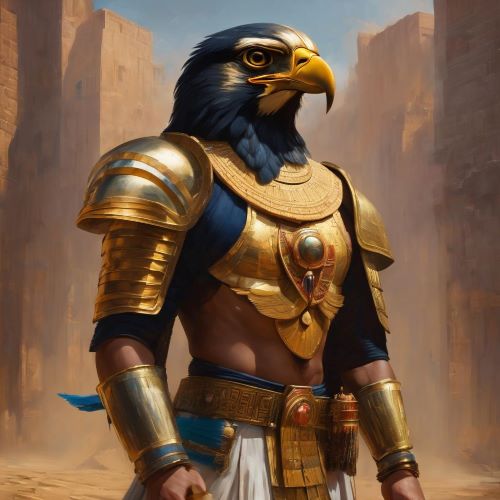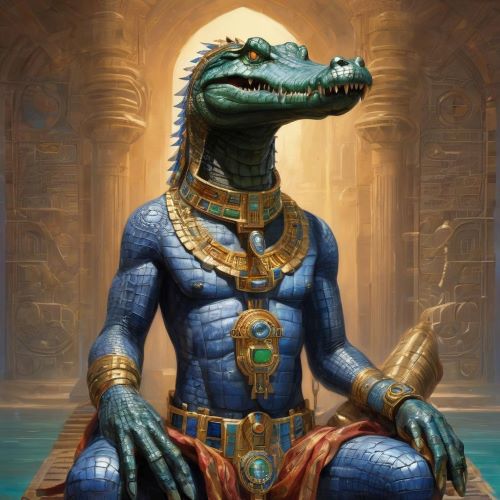Anhur : The Warrior God
Listen
At a glance
| Description | |
|---|---|
| Origin | Egyptian Mythology |
| Classification | Gods |
| Family Members | Ra (Father), Mehit (Wife) |
| Region | Egypt |
| Associated With | War |
Anhur
Introduction
Anhur, also known by his Greek name Onuris, is one of ancient Egypt’s most distinguished gods of war, hunting, and protection. His worship originated in the Thinite region near Abydos and later extended throughout Upper and Lower Egypt. The name “Anhur” is often translated as “Sky Bearer” or “He Who Brings Back the Distant One,” a title derived from his role in a myth where he retrieves the Eye of Ra—a lioness goddess – from Nubia and returns her to Egypt. This act symbolizes his duty as a restorer of order and protector of divine harmony. Anhur represented the ideal warrior: courageous, loyal, and disciplined, embodying the strength and valor the Egyptians admired both in their gods and in their armies. Over time, he became the patron of the Egyptian military and was often invoked by pharaohs before battle as a guardian of their campaigns and victories.
Physical Traits
Anhur’s iconography powerfully reflects his warrior essence. He is commonly portrayed as a tall, bearded man dressed in a long kilt or robe, crowned with a towering headdress of four ostrich feathers. This unique crown signified the four cardinal directions and the divine authority that extended across all of creation. The feathers also symbolized light and truth, aligning Anhur with Ma’at, the principle of cosmic order. He typically wields a spear or lance, emphasizing his title as “Lord of Lances,” a divine weapon master who destroys chaos and evil. In many depictions, he is shown striding forward energetically, spear in hand, embodying his readiness for battle. Occasionally, he is rendered with blue skin, associating him with the heavens, or with a lion’s head, signifying his ferocity and raw strength. The lion imagery further reinforces his role as a protector and as a being of immense power, capable of defending both gods and humans from threats.
Family
Anhur’s lineage is rooted deeply in Egyptian theology and varies across regions and time periods. He is often regarded as the son of Ra, the mighty sun god, situating him within the solar pantheon of protective deities who uphold balance and light. His consort is the lioness goddess Mehit (or Menhit), who features prominently in his most well-known myth. Mehit, an aspect of the Eye of Ra, fled to Nubia in the form of a lioness after a moment of divine rage, and it was Anhur who brought her back to Egypt, restoring peace and balance to the cosmos. This story not only highlights his courage and devotion but also his role as a reconciler who restores harmony between divine forces. In some traditions, Anhur is identified with Shu, the god of air, making him the brother of Tefnut, the goddess of moisture, and further linking him to the elemental balance of creation. His mother is occasionally identified as Hathor, another celestial goddess, strengthening his ties to the solar family.
Other names
Anhur’s name and identity underwent various transformations throughout Egyptian history and across different cultures. The Greeks referred to him as Onuris, a transliteration that became widely used during the Hellenistic period. Other forms of his name include An-Her, Inhert, Han-Her, and Anhuret. His epithets reflected his warrior role and divine attributes: “Slayer of Enemies,” “High of Feathers,” “Lord of Lances,” and “Sky Bearer.” In certain texts, when his identity merged with Shu, he was worshiped as Anhur-Shu, embodying both martial and atmospheric qualities; strength and air, power and breath. In the Nubian context, he was assimilated with Horus to form Horus-Anhur, who was later known as Arensnuphis in the Greco-Roman era. These transformations demonstrate the adaptability of his worship and his importance across regional and temporal boundaries.
Powers and Abilities
Anhur’s powers reflect his dual nature as both a divine warrior and a cosmic protector. As the patron god of the Egyptian army, he was invoked for strength, precision, and victory in battle. His primary weapon, the spear, represented divine will and the power to pierce through chaos, particularly embodied by the serpent Apep, the eternal enemy of the sun god Ra. In numerous myths, Anhur assists Ra in defending the solar barque during its nightly journey through the underworld, fending off the forces of darkness to ensure the sun’s rebirth at dawn. His prowess extended beyond warfare – he was also a skilled hunter, protector of travelers, and a symbol of the disciplined mind.
His role in the “Eye of Ra” myth reveals his abilities as a restorer and savior. In retrieving Mehit from Nubia, he not only demonstrates bravery but also acts as a reconciler of divine energy, bridging the distance between wrath and peace, chaos and order. In his later syncretic form, Anhur-Shed, he took on savior-like attributes, offering deliverance from evil, disease, and misfortune. Some Egyptian texts describe him as tall and mighty, with powers that included superhuman strength, flight, and command over both mortal and divine realms. He embodied the principles of valor, justice, and divine protection – qualities that made him a guiding force for Egyptian rulers and soldiers alike.
Modern Day Influence
Although ancient Egyptian religion faded millennia ago, Anhur’s legacy continues in modern scholarship, spirituality, and pop culture. His figure appears in various works of fiction, video games, and literature, ensuring his myth remains part of the global imagination. In the multiplayer online game SMITE, Anhur is featured as a playable god – depicted as a lion-headed warrior titled “Slayer of Enemies,” highlighting his ferocity and valor. The Assassin’s Creed: Origins video game also pays homage to him by including weapons and lore inspired by his mythology. In Rick Riordan’s novels The Throne of Fire and The Serpent’s Shadow, Anhur appears as a divine warrior figure, connecting young audiences with Egyptian mythology.
Beyond entertainment, Anhur has found renewed reverence among modern followers of Kemetic Orthodoxy and neopagan traditions, who seek to revive ancient Egyptian spirituality. Devotees honor Anhur in rituals symbolizing courage, victory, and protection, viewing him as a guide through personal and spiritual struggles. His qualities – strength, justice, and unwavering resolve – resonate with modern ideals of self-empowerment and resilience.
Anhur’s influence also extends to academic and cultural studies, where he is often examined as an early representation of the divine warrior archetype – a prototype for gods of war in later mythologies, such as Ares or Mars. His imagery, especially the four-feathered crown, has been featured in temple reliefs even during the Roman era, notably on depictions of Emperor Tiberius at Kom Ombo, where the emperor is shown wearing Anhur’s headdress to invoke divine authority.
Anhur’s enduring presence across centuries illustrates his universal appeal as both protector and liberator. His myth continues to inspire modern interpretations of heroism and cosmic order, bridging the ancient world’s fascination with strength and justice to today’s quest for balance and meaning.
Related Images
Source
Cedric Ferris. (2024). Anhur: Ancient Egyptian God Of War and Hunting. Mystery in History. https://mysteryinhistory.com/anhur/.
Ancient Egypt Online. (2019, April 30). Anhur. https://ancientegyptonline.co.uk/anhur/.
Myths and Sagas. (2024, December 27). Anhur – Egyptian god of war and hunting. https://mythsandsagas.com/wiki/egyptian-mythology/anhur/.
Onuris. (2002, September 29). Wikipedia. https://en.wikipedia.org/wiki/Onuris.
Storiespub.com. (2023, May 15). Anhur: The Fiery God Of War & Fertility In Egyptian Mythology. https://storiespub.com/anhur-egyptian-god-of-war/.
Iseum Sanctuary. (2022, January 16). Anhur, the Warrior Sky God. https://iseumsanctuary.com/2022/01/16/anhur-the-warrior-sky-god/.
Unnatural World Wiki. (2025, August 26). Anhur. https://unnaturalworld.fandom.com/wiki/Anhur.
Riordan, R. (2011). The Throne of Fire. New York, NY: Disney-Hyperion.
Wilkinson, R. H. (2003). The Complete Gods and Goddesses of Ancient Egypt. Thames & Hudson.
Pinch, G. (2002). Handbook of Egyptian Mythology. ABC-CLIO.
Hart, G. (2005). The Routledge Dictionary of Egyptian Gods and Goddesses. Routledge.
Bleeker, C. J. (1967). Egyptian Religion. University of South Carolina Press.
Dunand, F., & Zivie-Coche, C. (2004). Gods and Men in Egypt: 3000 BCE to 395 CE. Cornell University Press.
Frequently Asked Questions
What is lorem Ipsum?
I am text block. Click edit button to change this text. Lorem ipsum dolor sit amet, consectetur adipiscing elit. Ut elit tellus, luctus nec ullamcorper mattis, pulvinar dapibus leo.
What is lorem Ipsum?
I am text block. Click edit button to change this text. Lorem ipsum dolor sit amet, consectetur adipiscing elit. Ut elit tellus, luctus nec ullamcorper mattis, pulvinar dapibus leo.
What is lorem Ipsum?
I am text block. Click edit button to change this text. Lorem ipsum dolor sit amet, consectetur adipiscing elit. Ut elit tellus, luctus nec ullamcorper mattis, pulvinar dapibus leo.
What is lorem Ipsum?
I am text block. Click edit button to change this text. Lorem ipsum dolor sit amet, consectetur adipiscing elit. Ut elit tellus, luctus nec ullamcorper mattis, pulvinar dapibus leo.
What is lorem Ipsum?
I am text block. Click edit button to change this text. Lorem ipsum dolor sit amet, consectetur adipiscing elit. Ut elit tellus, luctus nec ullamcorper mattis, pulvinar dapibus leo.


